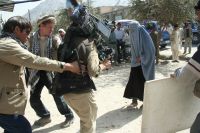Friday, April 19, 2024
News and Views from the Global South
CULTURE: Foreign Cash Makes Afghan Films
- After the fall of the Taliban, the most widely recognised and praised Afghan film has been ‘Osama’. Directed by Sediq Barmak, the 2003 production is the heartrending story of a young girl who disguises herself as a boy named Osama so that she might survive the Taliban regime. Osama received awards at both Cannes and the Golden Globes.
While all of the actors in the film were found on the streets of Kabul, the film nonetheless owes its life to foreign money.
The production was funded by Japan and Ireland. The production team that shot and directed the picture were actually Iranian.
Other post-Taliban era films follow a similar pattern.
‘Raqas Atish,’ released in 2002, and directed by Jawad Basel was created with help from the U.S. ‘Nelofar-e-Darbran’, another 2002 production, was backed by the French and directed by Hamayoon Kareempoor. More recently, the Wahid Nazari directed ‘Hejrat’, and the ‘Se Noqta’ by Roya Sadat – both released in 2004 – were also created with the help for foreign donors and production teams.
While these films were critically acclaimed, there is a view that overall, foreign influence has had a deleterious effect on the quality of Afghan cinema.
“In the past,” says Latif, president of Afghan Film Engineers, “film quality had value, but now the number of films has become more important than the kind of films we release.”
Some actors have quit the business entirely, saying that artistic motivation has been completely removed from the Afghan filmmaking process and replaced by a desire for only fortune and fame.
Qarar Aziz is one actor who got fed up with what he perceives as the commercialisation of Afghan cinema.
“Non-professionals have flooded the industry,” he says. “These private companies just work for money and fame.”
Mamoon Maqsoodi, another prominent Afghan film star also says that the rise of private companies over government funded film production have hurt the quality of filmmaking here by opening the industry to amateurs. Many popular Afghan films are actually remakes of Indian, Pakistani and Iranian hit movies.
“As it is important that a doctor should be a professional, so too must a film director,” Maqsoodi says. “But a doctor just deals with one person, whereas a film is seen by many tens-of-thousands. There is a major lack of professionalism in the industry right now.”
The upside of this change in the Afghan film industry is that more films are being made and the distribution networks are far wider than before. Some industry insiders say that viewership for locally made films has increased by as much as 80 percent over the last five years.
Shafiqullah Shayeq, head of the Actor’s Association of Nangrahar, says that some of the productions do manage to capture the national mood and unique aspects of Afghan culture in ways that government sponsored filmmakers could not. “There are some irresponsible production companies that are only interested in fame and fortune,” he allows. “But there are many that make fine, high-quality pictures that Afghans should be proud of.”
One of the major hurdles faced by Afghan movie-makers is the participation of women in films. Many directors say it is near impossible to find local actresses to appear on screen. As a result, local directors and producers have to bring in female talent from abroad in order to round out their casts.
Film star Maqsoodi says, “People look down on films here, from a moral standpoint. They see cinema as bad for our culture. Of course this isn’t true.”
Unfortunately, importing actresses hurts the realism of some Afghan films. Because the women are not Afghan, they don’t look like Afghans and their accents are very different from the different regional dialects that pepper Afghanistan.
Part of the problem may have to do with the borrowed plot lines and themes from other countries.
“When I make a film,” says Maqsoodi, “My film must present Afghan prestige and dignity. I don’t want to show young girls dancing in trousers and drinking wine.”
But Saba Sahar, an actress who also owns Saba Films, a Kabul-based production company, downplays this problem, saying that over the past few years it has become easier to find local, female talent.
“Two or three years ago this was a problem,” she says. “I had this problem then, but I don’t now. Only filmmakers in Nangrahar have this problem.”
Sahar, an actress who also owns Saba Films, a Kabul-based production company, blames the degradation of Afghanistan’s film industry on television, saying that filmmakers are drawn to the small screen because of TV’s much larger audience and global reach via satellite.
Many Afghan filmmakers have opted to work full time for well funded non governmental organisations (NGOs) who are constantly in need of instructional and documentary material.
*This was original published in the Killid Weekly. Killid, an independent Afghan media group, and IPS are partners since 2004.

 Print
Print




